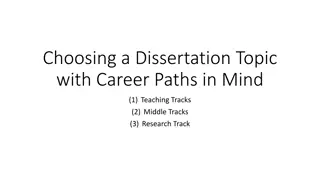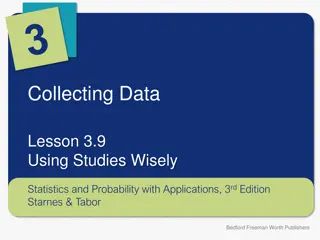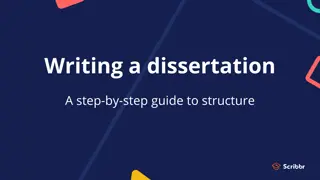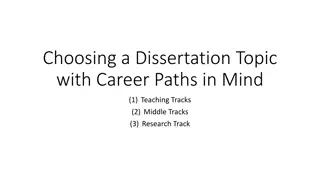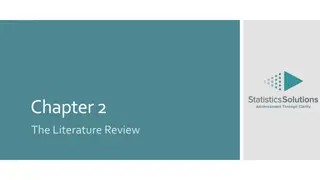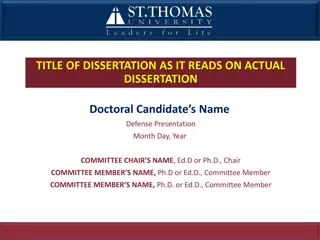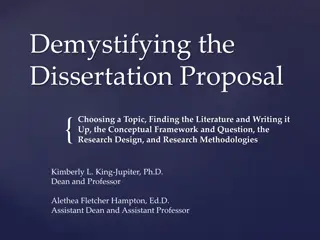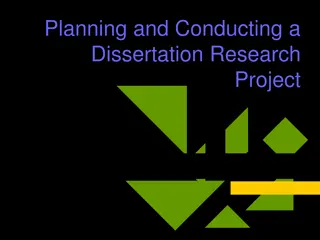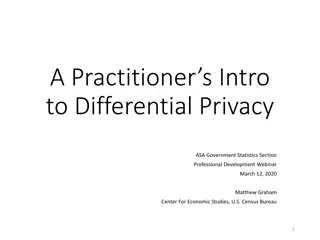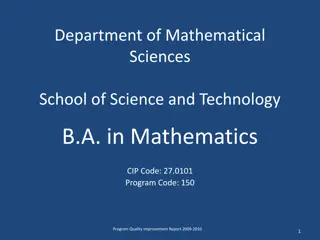Dissertation Guidelines for Mathematical and Statistical Studies
Guidance notes and timeline for structuring and submitting a dissertation in mathematical and statistical studies. Details include dissertation requirements, submission deadlines, penalty tariffs for late submission, and important information sources.
Download Presentation

Please find below an Image/Link to download the presentation.
The content on the website is provided AS IS for your information and personal use only. It may not be sold, licensed, or shared on other websites without obtaining consent from the author.If you encounter any issues during the download, it is possible that the publisher has removed the file from their server.
You are allowed to download the files provided on this website for personal or commercial use, subject to the condition that they are used lawfully. All files are the property of their respective owners.
The content on the website is provided AS IS for your information and personal use only. It may not be sold, licensed, or shared on other websites without obtaining consent from the author.
E N D
Presentation Transcript
Mathematical and Statistical Dissertations Part C and OMMS Dmitry Belyaev November 2023 1
Plan for this session Some information from the Guidance Notes Structuring a dissertation Referencing, examples Reminders 2
Some information from the Guidance Notes There is a webpage https://www.maths.ox.ac.uk/members/students/undergraduate-courses/teaching- and-learning/part-c-students/teaching-and-learning/dissertations containing important information about dissertations and in particular a link to the Dissertation Guidance. Reminder: a dissertation is worth the equivalent of 2 units. A dissertation is obligatory for OMMS students, Maths and Maths & Stats students, but optional for Maths & Phil students. Maths & Comp students must do either a maths dissertation or a CS project. The final dissertation should be no longer than 7,500 words, this usually equates to 25-30 pages. The word count may exclude any table of contents, all mathematical equations and symbols, diagrams, tables, bibliography and the texts of computer programs. This year there will be an absolute page limit of 50 pages; the page limit includes all materials. Full details specifying the details of the page limit will shortly appear on the Projects webpage and notice of 3 this will be circulated.
Timeline MT Week 0, Friday: Dissertation information session MT Week 0, Friday: Dissertation abstracts published MT Week 3, Friday noon: Deadline for submitting dissertation choices MT Week 5, Friday: Students notified of project allocation MT Weeks 7 and 8: First meeting with dissertation supervisor HT Weeks 1-8: Further supervision meetings HT Weeks 7-8: Oral presentations take place Deadline: 12 noon, Monday week 1 of Trinity Term. 4
Handing in When: Monday noon, Week 1, Trinity Term. What: all submission is electronic. An electronic version of your dissertation as a PDF needs to be submitted. Details will follow closer to the deadline re the submission process. 5
Penalty tariffs for late submission Don t be late! The following penalties expected to be confirmed in the Exam Conventions this term. Without permission from the Proctors to submit late: Lateness Mark penalty Up to 4 hours 1 4 24 hours 10 24 48 hours 20 48 72 hours 30 72 hours 14 days 35 More than 14 days late Fail E.g. if a dissertation achieving 65 marks is submitted 20 hours late, the penalty is 10 marks, so final mark = 65 10 = 55. Note: a technical Fail because of non-submission will result in the failure of the whole of Part C. 6
Marking The dissertation will be read and double blind marked by your supervisor and another assessor. The two marks are then reconciled to give the overall mark awarded. The reconciliation of marks is overseen by the board of examiners and follows the department s reconciliation procedure. When writing your dissertation, you should be aware of how it will be assessed and marked. Mathematics/Statistics or Data analysis/simulation 50% Other content 25% Presentation 25%. with the exception of History of Mathematics dissertations which are marked according to Content 75% Presentation 25%. These proportions are broken down further in the Dissertation Guidance. 7
Marking Mathematics/Statistics: Proofs and assertions should all be correct, written in your own words, and illustrated using your own worked examples. In applied topics, the derivation of the model should be properly justified. Data analysis/simulation: The data analysis has to be correctly and suitably done, including the choice of model. Similar comments apply to simulation. Content: You must do more than rehash text books and lecture notes. You should use multiple original sources, and present the material in your own words with your own critical overview. The Examiners are looking for your thoughts and contributions. The main thing to notice: . . . your own . . . . 8
Marking Presentation: The mathematics/statistics must be clearly typeset and well laid out; formulae must be clearly presented, tables and graphs properly referenced in the text; an abstract and a bibliography must be provided; the English should be clear and grammatically correct. Give some thought to notation, choice of typeface, and numbering of equations and sections. Do not fail to number the pages. Finally, be sure to supply complete and accurate references for all the sources used in completing the project, and be sure to cite them properly in the text. There are lots of resources on the departments website (and elsewhere online) regarding LATEX. https://www.maths.ox.ac.uk/members/it/faqs/latex 9
Structuring a dissertation Write with a reader in mind, e.g. yourself before you started on your project a friend at a similar stage (Part C/Masters level) maybe an examiner but remember that although an examiner could be an expert, an examiner may have little/no knowledge of your particular topic. Perhaps a friend at a similar stage is the best example: your work needs to be clear enough for your friend to understand it. The tasks of writing correct mathematics and explaining mathematics well are very different. It can become very easy to focus on the former and less on the latter. Being able to step back from the details and view a chapter or the dissertation as a whole is important. 10
Structuring a dissertation Some suggestions: You ll need to introduce your topic, explain what you are going to cover, the motivation and/or historical context for your work, why it is interesting, key examples might be introduced here,... a brief summary of how your dissertation is organised is a good idea. You ll probably need a small number of chapters (or sections) in which you do the main work. You ll need an end, e.g. some conclusions to your work, or a summary of what you ve done, perhaps a discussion of what further you might have discussed, related or more advanced problems, other approaches etc. or .... You ll need a title page, an abstract, any acknowledgements, a contents page,..., a bibliography. 11
Possible structure Title page Abstract Acknowledgements Table of contents Chapter 1 = introduction Chapters 2, 3, 4 = the main work Chapter 5 = conclusions Bibliography This is a guide, of course you can vary from it, e.g. it is completely reasonable not to have 5 chapters! But most of these things should be there (e.g. titlepage, abstract, contents, conclusions, bibliography). 12
Introduction In an introduction you should frame the dissertation, explain something of the problem s or theory s history and why it is of interest. This is a good time to introduce notation, background definitions and theory and key examples that you will return to through the dissertation. Describe the key results of your dissertation. Obviously you will need to have introduced enough vocabulary and examples that this is not an abrupt shift of narrative. After a good introduction the reader should be keen to read on and have a good sense of what content lies ahead. 13
Signposts Chapter 1 = introduction A very good idea for the intro to contain, e.g. as the last paragraph or two of the intro, an outline of the remainder of the dissertation signposts help the reader get a feel for the structure and let them know roughly what is coming. Chapters 2, 3, 4 = the main work Signposts at the start of each chapter are good too. 14
What to include While writing and planning the dissertation the word count of 7,500 may seem rather tight, but the word count should help you keep a reasonable handle on how much to write and what to include. Crucial definitions, examples and results will need to be introduced, and cannot be omitted, but not everything will need proving, especially if the proof of a theorem has no particular bearing or impact on the remainder of the dissertation. In this case quote the result and provide a suitable reference. Don t be completist, or verbose. Tangential or irrelevant asides should be avoided. By planning early, it should be clear if the word count looks like it is going to be significant problem. Then you need to think carefully about what to omit. It would be a great shame to write up a lot of material only for it to need removing in a later draft. 15
Referencing List references with full bibliographic details in a Bibliography (or References ) section at the end of your dissertation you don t want too few references (maybe aim for 10?) if you list something in the bioliography, you should refer to it at least once in the main body of the dissertation. Refer to the references at the relevant points in the text of your dissertation to help make your work self-contained to give credit where credit is due You must avoid plagiarism. [Reminder: plagiarism = taking someone else s writings or ideas and using them as if they were you own.] You don t need to give references for facts that are common knowledge in your discipline. E.g. In a Part C dissertation there is no need to give references to common facts from Parts A+B. 16
Examples A paper: Lauritzen, S. L. and Sheehan, N. A. (2003). Graphical models for genetic analyses. Statistical Science, 18, 489 514. A book: Venables, W. N. and Ripley, B. D. (2002). Modern Applied Statistics with S. Fourth Edition. New York: Springer. 17
Some examples Describing results other people have obtained: Smith (2010) has shown that .... Jones (2014) extended this result to the case where ... Describe how we are about to use someone else s work: We now use the general framework of Smith (2012) to obtain an approximation to ... We describe our extension to the work of Smith (2012), which allows us to incorporate . . ., in Section 3.2 . Explain how we are applying someone else s result to our situation: The conditions of Theorem 7.1 of Jones (2013) are satisfied by the test function f (j) = z jfor j 0, with z > 1 and sufficiently close to 1. Hence ... 18
Referencing In summary: it should be clear what is your own work and what is someone else s, and if you have used someone else s work it should be clear how you have used it. Referencing other people s work or ideas does not diminish the quality of your work, it enhances your work (and is essential). 19
Originality Few dissertations will include original research, and this is certainly not a requirement. Nonetheless a dissertation needs to be an original piece of work, in the sense that it offers something new to the literature. This might be achieved in various ways; commonly a dissertation seeks to take material available in various technical, professional sources and elucidate it for a more undergraduate/starting-graduate level. Other dissertations might seek to replicate known results, say about a model, the details of which aren t in the public domain. A dissertation is definitely not a regurtation or paraphrasing of a chapter or two of a particular resource. 20
Plagiarism The University s guidance on plagiarism is available at http://www.ox.ac.uk/students/academic/guidance/skills/plagiarism Plagiarism is presenting someone else s work or ideas as your own, with or without their consent, by incorporating it into your work without full acknowledgement. All published and unpublished material, whether in manuscript, printed or electronic form, is covered under this definition. Plagiarism may be intentional or reckless, or unintentional. Under the regulations for examinations, intentional or reckless plagiarism is a disciplinary offence. 21
Forms of Plagiarism Verbatim (word for word) quotation without clear acknowledgement Cutting and pasting from the Internet without clear acknowledgement Paraphrasing Collusion Inaccurate citation Failure to acknowledge assistance Use of material written by professional agencies or other persons Auto-plagiarism (i.e. using previously submitted work) 22
The Presentation Each student is required to give an oral presentation to their supervisor and at least one other person with some knowledge of the field of the dissertation. This presentation forms no part of the final assessment of the project. It is intended to give you an opportunity to practise your presentation skills and for your supervisor to test, through questioning, your understanding of the material included in the project. It is intended that the presentations will be delivered near the end of Hilary Term. 23
Reminders A comment from a recent examiners report: One point the examiners noted about dissertations was that some candidates forgot to attend to basic aspects of writing up when writing their dissertation: e.g. taking care with the number of significant figures, with figures/captions, explaining the problem they were studying clearly, etc. Some candidates may have al- lowed themselves to get distracted from such things when work- ing on a hard project it is important that all candidates spend enough time on the basic report writing aspects of their project. 2 4
Timing Finally some comments on timing: It is impossible to make general statements about the timing of a dissertation. Quite when you will be doing the work and then writing up will vary from person to person, depending on other workload and the nature of the dissertation s task. Nonetheless it is clear that the work needs to be done over two short vacations and Hilary Term, and that planning accordingly is vital. You should also factor into this the availability of your supervisor (e.g. how easy will it be to contact them during the vacations or if they are away at a conference?) The work and the writing up do not need to be done one after the other. You may find it helpful to write a chapter early on, especially if you are unused to LATEX or nervous about the writing process. It is not unusual for the introduction to be the last thing written. 25
Timing Getting maths right and explaining maths well are two different processes. This likely means you need to write logical, accurate maths first (for the more difficult results) and then revisit your writing to see how well you ve explained it to your notional reader. Do not underestimate the time it will take to do things. Be aware especially in term time that other things will intrude into your life. You will only stress yourself if you don t leave enough time to write up. Plan to be done comfortably ahead of the submission deadline. Do not be overambitious, or dedicate time to the dissertation at the expense of your other courses. Let the word count help you if it looks like you are going to go well over the word count that should be clear early on, and you should then consider (perhaps with advice from your supervisor) what to omit or abridge. Learn ways to take a step back. When writing, it s very easy to become so focussed on the particular theorem or topic at hand. Having a clear narrative, structure and plan for the dissertation will help you step back from such a mindset and better judge how the dissertation is coming along as a whole. 26






